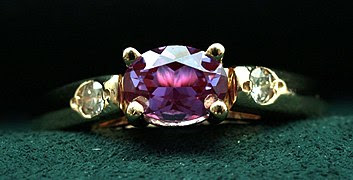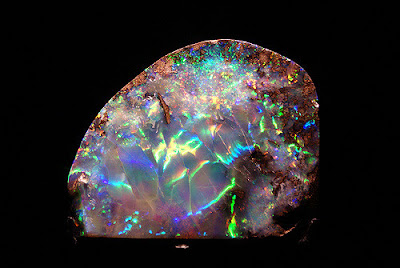Crystals & Gemstones - What’s the difference?
The two words gemstones and
crystals that we commonly use to represent those beautiful shiny things, are
quite different. A gem is a rare, high-quality solid mineral that can be
crystalline* in nature. If it has three attributes, a) beauty b) rarity and c)
durability then it is categorised as a gemstone.
Crystals are solids that
contain atoms, molecules and ions in a fixed order, in three dimensions, creating
a crystalline shape. Not all crystals will be made of a rare, high-quality
mineral.
*Crystalline in nature means its atoms are in certain definite geometric
patterns: snowflakes, diamonds, table salt. (Before you ask, sugar is
crystalline as chocolate, fudge, fondant, nougat, panned candies, marshmallows;
it is amorphous or non crystalline like hard candies, caramel, toffee, gummed
candies. My ass is not fat, just a little weight gain, because of the lockdown.
April 2020- April 2021)
Pyrite
crystal
Image by Volker Glätsch from Pixabay
Gemstones are made up of minerals They are generally more precious and expensive than crystals. Some gemstones, there aren't many, are made of organic matter. Purely organic gemstones are coral, natural (not lab created) pearls, ivory, jet and amber.
Mexican Amber with ant fossilized inside it
Photo courtesy of <a
href="http://gemologyproject.com/">The Gemology Project</a>
Emerald crystal from Colombia
Courtesy: <https://en.wikipedia.org/w/index.php?title=Emerald&oldid=1010014994>
A geologist or a gemstone professional will call an emerald an emerald only if he/she is certain that it is a crystallized beryllium-aluminium silicate mineral with trace amounts of chromium in it. (!) This is because there are other beautiful green gem stones which might fact turn out to be tsavorite, tourmaline or diopside.
Emerald-cut Kunzite (47.5 carats)
Photo Courtesy of Barbra Voltaire <a href="http://gemologyproject.com/">The Gemology Project</a>
Crystal Classification Systems
We know that
gems may be crystalline in nature and can therefore fall into both
categories. So how are they are differentiated from crystals? Gems are
categorized based on their chemical makeup – that’s what makes the gem the
gem that it is. What trace minerals can be found within it that make up the
colour scheme? How is it structured? Gems are then cut to size after their
value is determined.
If you want
to dig up some more information, please refer to http://www.geologyin.com/2017/03/gemstone-guide-classification-of.html
Crystals
are usually
classified by their shape. This means we have a cubic crystal, a tetragonal
crystal, or a hexagonal crystal, besides other classifications such as
orthorhombic, monoclinic and rhombohedral.
f you are someone who loves gemstones
and crystals the jargon can get a little confusing if you are not familiar with
geology or gemology. The identification, grading and sorting science behind the
subject is a vast field of knowledge comprising some technical skills as well.
You can pick up gem skills by taking a good course at a reputable
institute where you can learn gemology or diamond grading. (Check
out IIG in Mumbai, India; GIA - campuses worldwide; Instituto de
Geociências - Universidade de São Paulo; Brazilian Institute
of Gemology -Sao Paulo, Brazil )
To read
interesting lore about gemstones and to appreciate crystals, stay tuned
here. You can contact me for help with buying crystals if you are in India, or
gemstones if you are planning a trip to India. I also have some pretty
pieces, jasper, chalcedony and agate rings, necklaces which I will post
pictures of soon. We can help arrange exports to you of agate and crystal
pieces for bulk orders also. No one is going to judge you too hard on your gem
and crystal knowledge if you are not a crystal trader-dealer so just love your
crystals and stones, and get a little insight into the subject!
Tourmaline from Sao Jose da Batalha mine in Paraiba State, Brazil
Courtesy of Jason Barrett via <a
href="http://gemologyproject.com/">The Gemology Project</a>
Gemstones are cut, faceted and polished to be set in jewellery or to accentuate their value. How a stone is cut can create more brilliance and therefore more value. Here the gemstones used in this striking Rolex watch add real value to it besides making it a striking piece.
To
sum it up, a crystal is not a gemstone. Crystals are not rare nor are they
durable. They are simply crystals with an orderly pattern of atoms and
molecules. However, there are rare and expensive crystals such as alexandrite, tanzanite etc. we’ll
tell you about in another post.
Alexandrite ring
Courtesy of
<ahref="http://gemologyproject.com/">The Gemology
Project</a>
Morganite from Brazil
Courtesy of <ahref="http://gemologyproject.com/">The Gemology Project</a>
Some ‘crystalline’ minerals, namely, rubies, sapphires and emeralds that are durable as well as rare and beautiful may be termed gemstones. Remember not all gemstones are crystals. Gemstones of organic origin – Amber, Jet, Coral, Turquoise, Pearl – are not crystals at all. Neither are some gemstones like Lapiz Lazuli or Sunstone which are certain types of rocks!
Ruby
Courtesy of
<ahref="http://gemologyproject.com/">The Gemology
Project</a>
Rubies are one of the most precious gemstones in existence, commanding the greatest price per carat of any other gem. In Sanskrit it was called “Ratnaraj” which translates to “King of Precious Stones”. Experts around the globe haven’t quite yet settled on a precise explanation for how rubies are formed. We know that a ruby is, in essence, a type of corundum, which is itself colourless when pure, and turns ruby red when chromium gets mixed in it. The conditions needed to create rubies are so rare that a definitive explanation for their creation remains elusive.
Photo courtesy of Barbra Voltaire via http://www.gemologyproject.com/wiki/images/d/dc/Citrine_rough_and_cut.jpg













Comments
Post a Comment